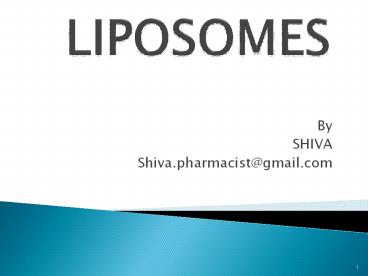liposomes - PowerPoint PPT Presentation
Title:
liposomes
Description:
liposomes – PowerPoint PPT presentation
Number of Views:2052
Title: liposomes
1
LIPOSOMES
- By
- SHIVA
- Shiva.pharmacist_at_gmail.com
2
LIPOSOMES
- Liposome are membranous vesicles formed by
dispersion of phospholipids in aqueous media.
They are small hollow spheres bound by a double
layer of lipid molecules in which the hydrophilic
heads of the molecules form the inner and outer
surface of the sphere, while the lipophillic
tails interwine in the middle.
3
LIPOSOME
HYDROPHOBIC
HYDROPHILIC
4
- ADVANTAGES
- Flexibility in the structure in entrapment of
water soluble as well as insoluble drugs. - Biodegradability
- Efficient control of release.
- Resemblance to natural membrane structures.
- Increased targeting prospects.
- Beneficial modification of pharmacokinetics of
the drug. - Facilitation of transport across membranes.
- Adjuanticity of vaccines
5
- DISADVANTAGES
- The development of liposomes at industrial level
is difficult due to its physiological and
physicochemical instability. - They aggregate and fuse together upon prolonged
storage disturbing the reproducibility. - They are prone to degradation by oxidation and
hydrolysis.
6
CHARACTERISATION
- Size and size distribution
- Lamellarity
- Entrapped volume
- Solute distribution
7
Classification based on structural parameters
MVV Multivesicularvesicles (gt 1.0 UM)
MLV Multilamellar Large vesicles (gt0.5 um)
OLV oligolamellar vesicles (gt0.1-1.0 um)
UV UnilamellarVesicles (all size ranges)
Based on structural
SUV 20-100nm
MUV
LUV gt100nm
GUV gt1um
8
Multilamellar vesicles
Unilamellar vesicles
9
MECHANISM OF ACTION
- Endocytosis
- Adsorption to cell surface
- Fusion with plasma cell membrane
- Transfer of liposomal content
10
METHODS OF PREPARATION
- Physical dispersion methods
- Solvent dispersion
- Detergent solubilisation
11
Physical dispersion methods
- Hand shaking method
- Non shaking method
- Pro liposomes
- Freeze drying method
12
HAND SHAKING METHOD
13
- SOLVENT DISPERSION METHODS
- Ethanol injection
- Ether injection
- Water in organic phase
- Double emulsion vesicles
14
Ethanol/Ether injection method
15
- Handling of liposomes
- Liposomes have a standard composition- egg,
lecithin, cholesterol, phosphotidyl glycerol in
molar ratio of 0.910.1. these lipids are stored
as solids or in organic solution at -20C or
-70C in order to reduce oxidation. The solvent
is mixture of chloroform and methanol(21).
Stored in dark glass vessels. - Drying Gentle warming at 20C to 40C under
reduced pressure. Rapid rotation increase surface
area for evaporation.
16
PURIFICATION OF LIPOSOMES
- Commonly purified by gel filtration column
chromatography or dialysis or centrifugation. - In column chromatographic separation, Sephadex
G-50 is most widely used material. - In dialysis method, hollow fiber dialysis
cartridge may be used. - The separation of liposomes by centrifugation
method depends on the size as well as the
composition of the bilayers.
17
INVITRO BEHAVIOUR OF LIPOSOMES
- IV route is the most popular route. Three
pathways are there for drug release. - Destabilization of liposomes
- Delivery of liposomes to the monounuclear
phagocyte system(MPS) - Sustained release of liposome encapsulated drug
by long circulating liposomes.
18
APPLICATIONS
- Enzyme replacement therapy
- Delivery of antibodies, antigens and vaccines
- Hormones and blood factors
- Blood substitutes
- Interferon
19
Thank you































